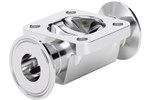Bürkert Fluid Control Systems has re-engineered its diaphragm valves to maximize longevity and operating efficiency.
The principal aims of the project were to increase Kv values, extend diaphragm lifetimes and improve the interface between the valve body and the diaphragm to make it easier to change the sealing materials. This would be achieved through improvements to the machining and polishing processes as well as changes to the geometry within the valve body.
Improving flow characteristics are best determined by the Kv value, which defines the flowrate through a fully open valve and is also the sizing factor used to calculate the pressure drop across the valve. As such, a higher value indicates less restricted flow and Bürkert aimed to improve the figures for the existing products by up to 40 percent. This in turn would reduce energy requirements and improve efficiency.
The durability of the diaphragm is determined by its interaction with the valve body, the compressor and the actuator. Part of the re-engineering process addressed the design of the compressor, which now has improved sealing properties as well as a bayonet coupling that is common to both elastomer and PTFE diaphragms.
The project has also made improvements to the finished surface of the forged valve body by removing the need for manual polishing and improving the electro-polishing process, with the surface roughness to less than 0.38 µm.
Image courtesy of Burkert Fluid Control Systems


